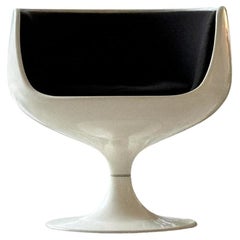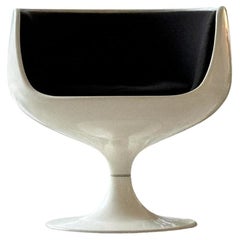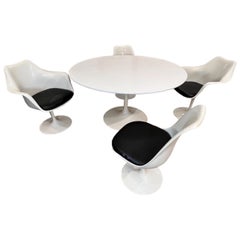DESIGNGUT Dining Room Sets
to
Height
to
Width
to
Depth
to
2
2
2
2
2
2
2
2
2
2
2
2
2
2
Set of 2 Cognac XO Chairs by Eero Aarnio for Asko
By Asko, Eero Aarnio
Located in Telgte, DE
Set of 2 Cognac XO Chairs by Eero Aarnio for Asko – Perfect Addition or Standalone Pieces for Design Enthusiasts
These two original Cognac XO Chairs by Eero Aarnio for Asko are true...
Category
Mid-20th Century Finnish Space Age Dining Room Sets
Materials
Fabric, Fiberglass
$10,628 / set
Set of 4 Cognac XO Chairs & Matching Table by Eero Aarnio for Asko
By Eero Aarnio, Asko
Located in Telgte, DE
Set of 4 Cognac XO Chairs & Matching Table by Eero Aarnio for Asko
An iconic piece of Mid-Century design – this set of four Cognac XO Chairs and the matching table, designed by Eero...
Category
Mid-20th Century Finnish Space Age Dining Room Sets
Materials
Fabric, Fiberglass
Related Items
Iconic Eero Aarnio Small Black Mushroom Stool
By Eero Aarnio
Located in New York, NY
He mushroom is one of Eero’s oldest designs and in its fibreglass form is part of the same design family that includes the ball chair, Pastil and Tomato. It can be used as a stool or...
Category
2010s Finnish Modern Footstools
Materials
Fiberglass
1970’s Eero Saarinen for Knoll, Tulip form Table & 4 Chairs, 2 side 2 arms
By Eero Saarinen, Knoll
Located in Huntington, NY
1970’s Tulip form Table & 4 Chairs, Eero Saarinen for Knoll,
circa 1970, A stylish and iconic design, this tulip dining table and four matching swivel dining chairs were designed by...
Category
Vintage 1970s American Scandinavian Modern Dining Room Sets
Materials
Aluminum
$6,160 Sale Price
30% Off
H 28.5 in Dm 54 in
Eero Aarnio Small Walnut Parabel Table
By Eero Aarnio
Located in New York, NY
The Parabel was designed in 1993 by Eero Aarnio, and first shown at the International Furniture Fair in Cologne, Germany in January 2002. The table is made of fibreglass and comes in...
Category
2010s Finnish Modern Tables
Materials
Maple
Jean Prouve by G-Star Raw for Vitra S.A.M. Tropique Table with matching chairs
By Jean Prouvé
Located in amstelveen, NL
2011 Jean Prouvé by G-Star Raw for Vitra S.A.M. Tropique table with matching standard chairs. This limited edition table was only produced in this version for one year in 2011. Other...
Category
2010s European Post-Modern Dining Room Sets
Materials
Steel, Stainless Steel
$53,997 / set
H 28.75 in W 98.43 in D 35.44 in
Eero Saarinen Tulip Oval Carrara Arabescato Marble Tulip Table for Knoll, 1967
By Knoll, Eero Saarinen
Located in Vicenza, IT
Tulip oval dining table designed by Eero Saarinen in 1957 and manufactured by Knoll in 1967.
Composed of a white lacquered pedestal and a tabletop made of ...
Category
Vintage 1960s Italian Space Age Dining Room Tables
Materials
Carrara Marble
$11,999
H 28.75 in W 47.64 in D 77.96 in
Midcentury Space Age Coffee Table UPO, Eero Aarnio, Finland, 1970s
By Eero Aarnio
Located in Praha, CZ
- Rare type
- Very practical
- Marked.
Category
Vintage 1970s Finnish Mid-Century Modern Coffee and Cocktail Tables
Materials
Metal
$834
H 17.72 in W 33.47 in D 33.47 in
Mod Wicker Side Table Att. to Eero Aarnio
By Eero Aarnio
Located in New York, NY
Cool Mod style pod table in woven wicker, attributed to Eero Aarnio. The side table is in very good, original estate condition, it shows an inconsequential bruise on the underside, n...
Category
Mid-20th Century Finnish Mid-Century Modern Patio and Garden Furniture
Materials
Wicker
Dining Table "Tulip" with marble top by Eero Saarinen for Knoll International
By Knoll, Eero Saarinen
Located in Beograd, RS
In this listing you will find an iconic design piece, a Space Age "Tulip" dining table designed by Eero Saarinen for Knoll International. It features a cast aluminum base with the m...
Category
Vintage 1950s Italian Space Age Dining Room Sets
Materials
Marble, Aluminum
$6,000
H 28.35 in Dm 35.83 in
Dining Table & Chairs Set by Boris Tabacoff for Mobilier Modular Moderne, 1970's
By Boris Tabacoff
Located in Antwerp, Antwerp
A spectacular ‘Scimitar’ dining set designed by Bulgarian designer Boris Tabacoff for Mobilier Modular Moderne (MMM) in the 70’s. The chairs and table have a heavy chromed steel base...
Category
Vintage 1970s Bulgarian Space Age Dining Room Sets
Materials
Chrome
$8,598 / set
H 30.71 in W 51.19 in D 51.19 in
1970s Rosewood Tulip Dining Table & Six Chairs Set By Eero Saarinen for Knoll
By Eero Saarinen
Located in Shepperton, Surrey
An original 1970 vintage tulip dining set by Eero Saarinen for Knoll.
Saarinen's tulip design combines grace with practicality. The rare Rio...
Category
Mid-20th Century Finnish Scandinavian Modern Dining Room Sets
Materials
Metal
$13,139 / set
H 28.35 in W 53.94 in D 53.94 in
Eero Aarnio Solid Pine wood drop leaf dining table Laukaan Puu 1970s
By Eero Aarnio, Laukaan Puu
Located in Den Haag, NL
Solid Pine ,drop leaf dining table design by Eero Aarnio for Laukaan Puu,
1970s . Very easy to use . One drawer used on both sides .
64 cm to 180cm Good condition .
Category
Vintage 1970s Finnish Mid-Century Modern Drop-leaf and Pembroke Tables
Materials
Pine
$1,379
H 28.35 in W 70.87 in D 31.5 in
Space Age Dining Set with Six Cobra Chairs by Giotto Stoppino and Matching Table
By Giotto Stoppino
Located in Milano, IT
Table set - 6 dining chairs and Table - Giotto Stoppino
Born 1926, Giotto Stoppino was one of the most relevant representative of the Italian Space Age movement. He worked as an ar...
Category
Vintage 1970s Italian Space Age Dining Room Sets
Materials
Metal, Steel, Chrome
$9,503 Sale Price
20% Off
H 29.53 in W 25.6 in D 19.69 in


